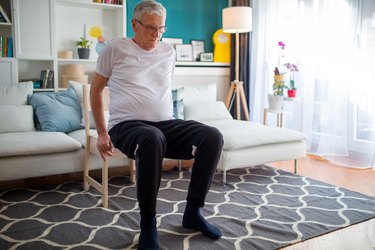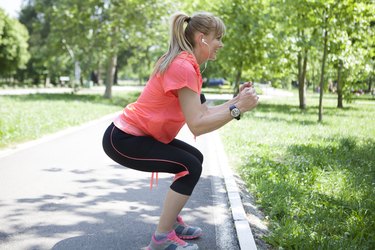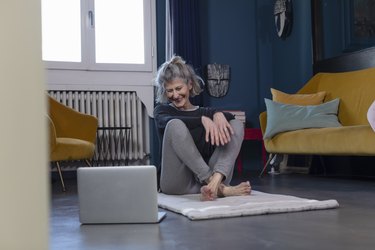
Placing a book on a high shelf, bending over to pick something up, getting up from a chair — there are a few daily motions that can feel a lot more challengingas we age.
When you have trouble getting out of a chair, it's a sign that you may need to give your mobility and strength training some extra attention, saysMelissa Garcia, DPT, CSCS, a Washington-based physical therapist. Over the long term, some simple exercises can help improve your balance and stability, reducing your risk of injury and falls.
For those who need a little extra help getting up from the toilet or couch, quad, glute and hamstring strength is a top priority, she says. To help make your daily movement a little easier, she recommends you do these exercises every other day (or every two days if you notice your muscles are especially sore afterward).
Exercises to Help Getting Up From a Chair
Move 1: Glute Bridge
Glute bridgesare a top exercise Garcia recommends for people having trouble getting up from a chair. This move strengthens your glutes and hamstrings (major muscles used when standing up), and your two main hip extensors.
“臀部扩展是行动,让我们的身体ies to comfortably stand up straight," she says. And the glute bridge allows you to practice this motion in a lying down position, offering a little. more support and control.
- Lie on your back with your arms at your sides, feet flat on the ground and knees bent.
- On an exhale, squeeze your glutes, press into your heels and drive your hips up toward the sky.
- Raise your hips until you form a diagonal line from knees to hips to chest.
- Pause here for a moment.
- Reverse the motion and return to the starting position.
Tip
For some extra stability, do this move on the floor next to a couch or sturdy chair to help you more easily get down onto and up from the ground.
But ifgetting down onto the floorfeels challenging or uncomfortable, you can do this exercise lying down on a bed or couch.
Move 2: Straight Leg Raise
Opposite glute bridges, straightleg raiseshelp strengthen your hip flexors (the muscles running across the front of your hips). But these also target your core and help strengthen your quads (the muscles across the front of your legs). Leg raises even build muscle endurance (so you don't get tired as quickly) and control while keeping you in a comfortable, lying-down position.
"Notice that once your quad starts to fatigue, your knee will start to bend," Garcia says. "If this happens, take a break until you feel ready to try another repetition."
- 开始by lying down on the ground or on a couch with your knees bent, feet flat on the ground and arms at your sides.
- Straighten your right leg, placing the heel on the floor.
- Rooting your left heel into the ground, slowly raise your right leg a few inches to a foot off the ground, keeping the knee as straight as possible.
- Pause for a moment and gently bring your right leg back to the ground.
Tip
When you doexercises lying on the floor, you want your lower back to be as flat against the ground (or bed) as possible. If this feels uncomfortable, you can place a thin pillow or towel underneath your back for extra support and comfort.
Move 3: Side-Lying Hip Abduction
Your glutes are the biggest muscles in your lower body. But when these muscles are weak, they can cause your back to take over when you're doing day-to-day activities like getting up from a chair or picking something up off the ground.
Garcia likes this exercise because it targets the hard-to-reach muscles in yourside glutes. Plus, the side-lying position helps you really isolate the muscles, so you're not using other parts of your lower body to help complete the exercise.
- Lie on your right side with your legs straight and hips stacked. Place your right arm under your head and left palm on the ground for support.
- Gently bend your right knee to a 90 degree angle, keeping your left leg straight and extended.
- Slowly raise your left leg a few inches to a foot off the ground.
- Pause for a moment.
- Lower the left leg back to the ground.
Move 4: Supported Mini Squats
"This is essentially the mini version of getting out of a chair," Garcia says. Many people struggle to get up out of a chair because they have trouble keeping their balance. But the mini squat exercise practices that motion, while still offering a little extra help with balance.
- Stand behind a sturdy chair or couch, placing your hands on the back rest for extra support.
- Move your feet to about hip-width distance.
- Gently push your butt back and bend your knees to about a 45-degree angle.
- Reverse the motion and push your hips forward to return to standing.
Tip
Try to keep your weight evenly distributed across your feet, Garcia says. This helps provide extra stability while you're doing this exercise.
Additional reporting byBojana Galic.
- Harvard Health Publishing: “5 Tools to Help You Stand Up on Your Own”
- Harvard Health Publishing: “Two Questions Can Reveal Mobility Problems in Seniors”
- JAMA: “Mobility Limitation in the Older Patient”
- BioMedical Engineering OnLine: “Peak Hip and Knee Joint Moments During a Sit-to-Stand Movement Are Invariant to the Change of Seat Height Within the Range of Low to Normal Seat Height”
- American Council on Exercise: “5 Chair Exercises for Older Adults”
- Centers for Disease Control and Prevention: “Chair Rise Exercise”
- Los Angeles County Government: “Exercise for Older Adults”






